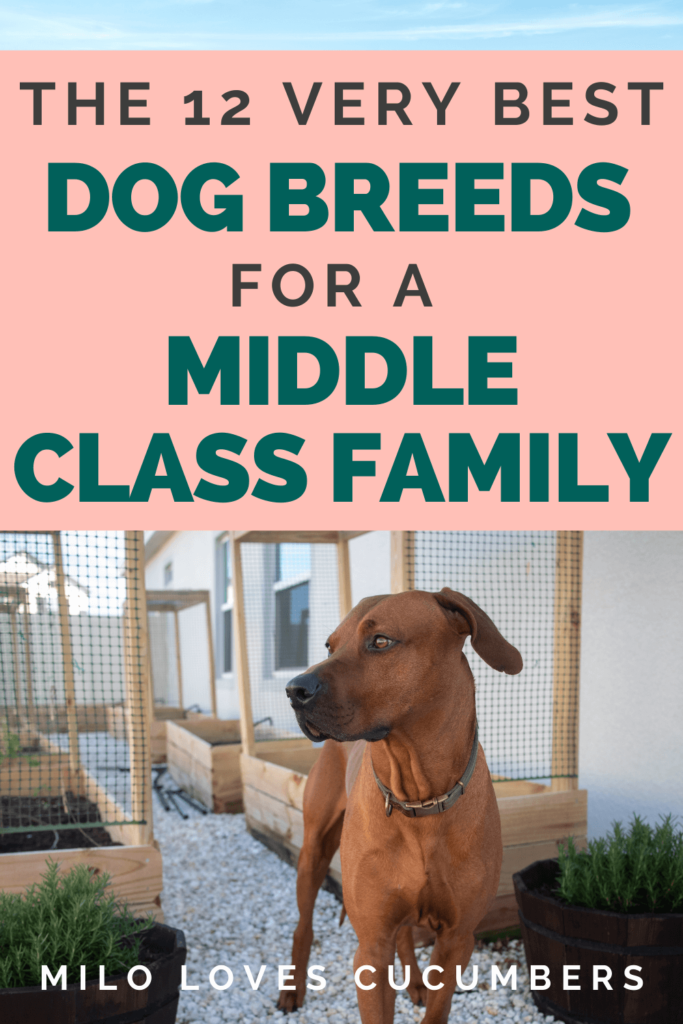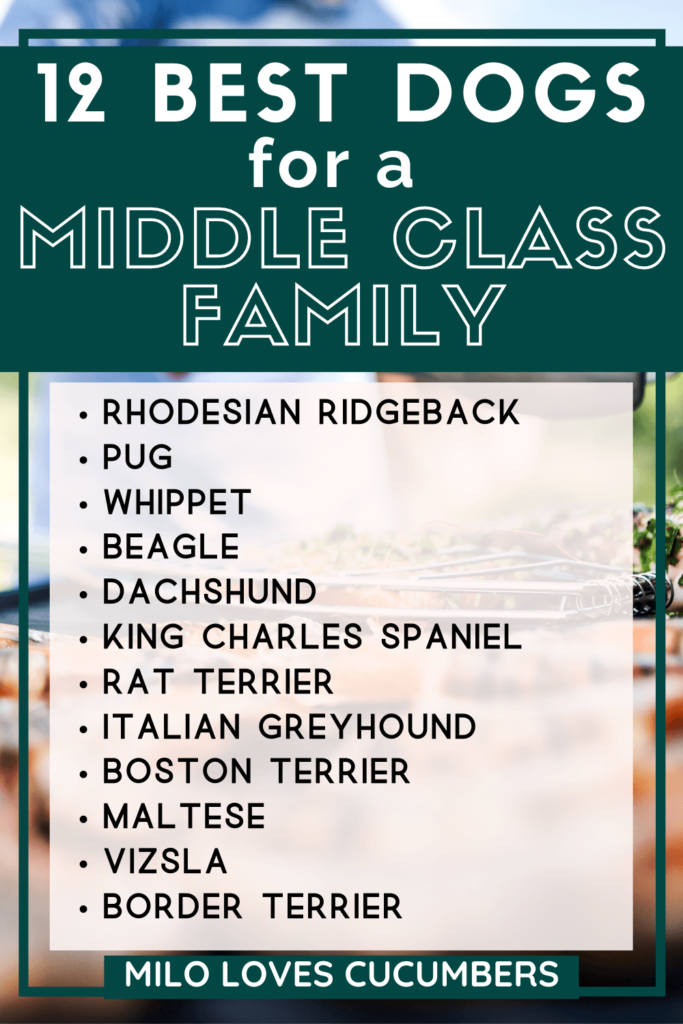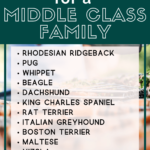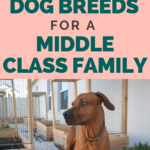When we first decided to get a dog, we did a bunch of research on different dog breeds that would fit our lifestyle. We wanted a dog that was on the lower-maintenance side who was good for families and didn’t require endless hours of training. Sounds like the perfect dog, right? Well through all that research we found a few of the best dog breeds for a middle class family – and I knew I had to share with you so that you could decide on the best dog breed for your family!
Best Dog Breeds for a Middle Class Family:
- Rhodesian Ridgeback
- Pug
- Whippet
- Beagle
- Dachshund
- Cavalier King Charles Spaniel
- Rat Terrier
- Italian Greyhound
- Boston Terrier
- Maltese
- Vizsla
- Border Terrier
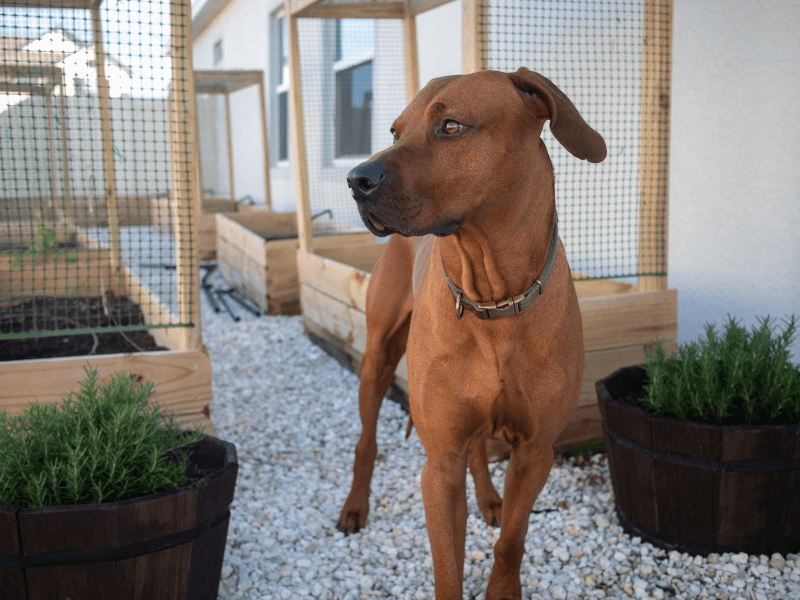
Disclosure: This post may contain affiliate links. If you purchase a product through one of our affiliate links we make a small commission from the sale at no extra cost to our readers.
DOG BREEDS FOR A MIDDLE CLASS FAMILY
Choosing a dog breed is an important task. You want to choose a breed that works well with your lifestyle – whether that’s an active one or more of a laid back routine.
This list of AKC registered dog breeds for a middle class family will help you decide which breed is best for your family based on the type of lifestyle you have an how much space you can dedicate to your new furry friend!
1) RHODESIAN RIDGEBACK
Naturally, I have to talk about this breed first!
Rhodesian Ridgebacks have been bred to hunt and are strong, independent, athletic breeds.
And normally you wouldn’t associate those qualities with a family dog – but hear me out.
Ridgebacks are super smart as a breed – which means they’re quite easy to train. They are also very protective – which is great for a family guard dog!
And even though they are pretty large (and very strong) they are surprisingly gentle and great with kids!
You can get a wheaten-colored Ridgeback , which is paler, or the auburn (red) wheaten like Milo.
Most Rhodesians have a black nose and some sort of black masking on the face.
Also known as African Lion Hounds because of their historic prowess in hunting for lions, Rhodesians make the perfect guard dog for the family home.
But they are not barkers so if you hear your Rhodesian barking, find out what’s going on ASAP.
Rhodesians are also low-maintenance since they don’t need too much grooming. A brush-down once a week to remove excess hair does it for them. And they don’t need frequent bathing, either.
It is important to note that Rhodesian Ridgebacks can become obese if their food is not regulated. Monitoring portions and training them to be satisfied with it helps keep them in shape.
2) PUG
The adorable pugs are identifiable by their wrinkled face, big intense eyes, and a flat schnozzle.
Pugs also love to cuddle and show affection, and they’re just happy to hang out with you on the couch while you watch tv or read a book.
Plus, pugs don’t need a lot of exercise. 20 minutes is enough for a pug to be happy, content, and healthy. They are also playful and good with children, as well as other animals such as cats.
They are quick learners, which is a plus if your schedule is hectic. And they are smart and observant.
They’ll quickly learn where you’ve hidden all the treats and cause chaos!
Pugs like to sleep so you can be sure your days will be more relaxed, but they have quite an appetite and are more prone to obesity if their meals are not regulated.
3) WHIPPET
Whippets are adorable and they love to be around people.
Plus, they are gentle and friendly, which works well with kids!
They have a short coat, which makes it easy to groom them. A brush down and a weekly wash is enough to keep them well-groomed and clean.
So if you have a busy schedule, you can rest assured that whippets will adapt and properly blend in.
Whippets also adapt well to city life as they hardly bark and are not aggressive with other dogs.
Other than the weekly cleaning of their coat, you should be sure to keep their nails trimmed, as long nails cause a lot of discomfort for this sporty breed.
So if you’re looking for a low-maintenance, gentle, patient dog, a whippet may be the breed for you!
4) BEAGLE
Beagles are a lovable, easygoing, lively, and happy breed.
They’re good with children and other dogs, too. Beagles are low-maintenance because their coat is short and doesn’t require regular grooming.
Plus, beagles are small so they don’t take up so much space, which is advantageous because they don’t need a big bed or large amounts of food.
They are pretty adaptable to any living conditions. And even though they could use a backyard, they don’t mind playing in the park.
Beagles do bark pretty loud in comparison to other breeds on this list, so if you’re in an apartment then that’s something to consider!
5) DACHSHUND
Whether you want the wirehaired, the shorthaired, or the longhaired kind, dachshund dogs are a small-sized breed that is curious, has a great sense of humor, and is loyal to their family!
And even though Dachshunds need their daily walk, they don’t need vigorous workouts. Moderate exercise does it for them.
It is important to note that Dachshunds are runners and can chase small animals. Therefore, you must keep your dachshund on a leash when you’re outside.
Due to different types of coats, some dachshunds shed more than others but as a breed, they’re generally moderate shedders.
Grooming dachshunds is easy depending on their coat. Long Haired breeds may need more frequent brushing to prevent forming mats. And the breed as a whole requires regular bathing every other week or so.
6) CAVALIER KING CHARLES SPANIEL
Cavaliers are as low maintenance as they get. They hardly ever get allergies. And they shed their coat but with proper grooming, it can be reduced.
This means that they don’t need extensive grooming but to prevent their coat from tangling, brush them at least once a week.
Cavaliers are gentle, sweet, and loyal to the bone.
They love being around people and love pleasing their owners, plus they’re great around children.
Due to their small size, they don’t take a lot of space. Which means that it doesn’t cost a lot of money to buy their bed and other doggie stuff.
Cavaliers are runners and chasers, however, so if you don’t want your pup getting lost, they should have a leash whenever you’re out.
7) RAT TERRIER
Rat terriers are a hunter of small animals, and naturally, they are on the smaller end of dog breeds.
Like all terriers, rat terriers are fearless and spirited companions that love to dig and run after small animals.
They are loyal, playful, and active for most of their life. They are, however, cautious with strangers, but are good in a household that has children.
For any middle class family with an active lifestyle, this breed will definitely be a great fit!
Rat terriers are also easy to train since they’re pretty intelligent. Give them at least 30 minutes to one hour of exercise per day and they are good to go!
And grooming a rat terrier is pretty easy. Their coat is short and can be brushed down occasionally to get rid of dead hair.
All these things combined make the Rat Terrier one of the best dog breeds for a middle class family!
8) ITALIAN GREYHOUND
If you want a low-maintenance hound, the Italian greyhound is the dog for you!
This breed loves human companionship and is great as a house dog.
Italian greyhounds are quick to learn and easy to train, which is great news because they don’t take too much of your time.
They’re also fearless and cheerful – and get along very well with other pets too!
Italian greyhounds are easy to groom because they have a thin coat that sheds very little, brushes easily, and is odorless.
Plus, apartment dwellers will be especially happy to know that this dog breed is not a big barker – pair that with the fact that this breed doesn’t get any bigger than 20 pounds and this is really a perfect apartment dog breed!
9) BOSTON TERRIER
I find Boston Terriers adorable because of their signature black and white tuxedo look,making them look like a little penguin!
Plus, Boston Terriers are great dog breed for middle class families since they are a low maintenance dog breed.
They have a short hair coat that requires minimal maintenance. And they are a smaller breed even full grown which is ideal for homes with children or the elderly.
Boston terriers are loyal, sensitive, friendly to strangers too. Plus they relate well with other dogs.
They also adapt well to living in an apartment!
They shed minimal fur and don’t drool much, which is a big plus – at least for me!
Bostons are playful and intense, and also need regular exercise and playtime. Especially since they often suffer from separation anxiety if left alone for a long time.
But don’t let that deter you from getting a Boston Terrier!
You can train them to stay home alone until you’re back from work. It may be challenging at first but Boston Terriers are good at adapting to the environment.
10) MALTESE
Maltese dogs are a well-loved and popular breed – and for good reason!
They are small, perfect for busy families, and are good with the elderly.
They are vibrant, friendly, and loyal to their owners. And even though they are a pretty small dog breed, they make excellent guard dog due to their fearless nature.
And they have no problem barking when they hear an intruder!
Maltese require less space to play in and prefer to stay close to their people – making them great lap dogs.
Plus, grooming a Maltese is not super complicated – they have minimal shedding but their coats do mat easily. However, brushing them regularly can combat that issue.
One consideration though is that they might need to be bathed more – they are very playful so when they roll around in the dirt, they’re snow white coat becomes a lovely grey color!
11) VIZSLA
Vizslas are intelligent, friendly, affectionate dogs that are also gentle and lively. They are great with families and love to play with young kids.
They are a very active breed, though, and may require more exercise than other breeds. They love jogging, long walks, and other doggie activities such as playing fetch.
But on the flip side, they don’t require a lot of maintenance since they have short coats which don’t give off a strong odor!
They are also low shedders – one good brush a week does it for them!
12) BORDER TERRIER
If you have minimal living space in your home and want to own a low-maintenance pooch, a Border Terrier is a great choice!
They are fast learners when it comes to simple tasks such as going potty, but they do have difficulty learning complex tasks. With the right training and a little patience, however, they can learn almost anything!
Border Terriers don’t need much in the grooming department, either.
Their coats are rough enough to repel dirt so giving them a gentle brush down once a week and an occasional good wash should do just fine.
And while Border Terriers don’t rely on having human companions as other breeds do, they are observant, eager to please their owners, and are loyal too!
TIPS FOR SELECTING A MIDDLE CLASS DOG BREED
Selecting the perfect dog breed is a hard choice, especially since there are so many adorable breeds out there!
But no matter which breed you find most adorable, below are factors to consider before bringing home your next fur baby:
Living Space
When looking to get a dog, your living space is a major factor to consider.
Do you live in an apartment? Do you want your home to be sparkly clean at all times?
These factors should come into play when you want to add another member to your family. Consider how much of a mess certain breeds will make, how larger breeds can knock over valuable items in the house, and the difficulty of potty training certain breeds.
Compatibility
Having a dog that’s compatible with the rest of your family is important for easy living.
For example, if you have a dog that feels threatened by children, it may not be the best breed for you if you have kids.
Also, if you’re allergic to fur, you wouldn’t want a dog that sheds too much!
Age
The dog’s age is another factor that is important to look into.
You may want a puppy to grow with, but puppies are more temperamental than adult dogs and may require more training time.
Also, you can’t leave a puppy for longer than a few hours, while you can leave an adult dog for up to 8-12, hours depending on the breed.
History
It is important to know the history of the dog you want to get.
Is it from a good home, or are you adopting from an animal shelter?
Note that some animals in the shelter have dark pasts such as abuse, malnourishment, abandonment, etc, and their personalities may have developed based on those experiences.
This is not to say that you shouldn’t adopt, but adopting a dog with a dark history will likely need more love, attention, and patience.
Energy Level
If your energy is low and the idea of an afternoon walk sounds horrible, it wouldn’t be a good decision to get a high-energy breed.
But if you have an active lifestyle, you should get a dog that matches your energy. So if you love hiking, going for runs, and long walks around the neighborhood, you should get a high-energy pooch.
And if you’re the lay-on-the-couch type of person, getting a low-energy dog will work out much better in the long run!
Size
The size of the dog matters a lot.
If you have small children, having large dogs can be a safety hazard because kids might be knocked over or stepped on when the dog is playing rough.
Your living space may also not accommodate a large breed.
You might want to consider the cost of maintenance such as food, bed size, vet bills, grooming, etc.
The larger the breed the more expensive it gets – trust me! And let’s be honest, maintaining a Maltese and a Mastiff is a very steep contrast, don’t you think?
Schedule
Another important factor when selecting a breed is your schedule.
Are you available to give a dog the attention it needs?
If you have a busy schedule, breeds that demand a lot of attention won’t work for you. Some dogs don’t need as much human companionship, while other breeds suffer from separation anxiety and can become destructive.
At the end of the day, choosing the breed that’s right for you will be dependent on your overall lifestyle. But just like humans, dogs aren’t perfect either. So consider the above list of dog breeds for a middle class family, but also remember that no matter which breed you choose, you’ll need to have some patience when you bring them home!
Pin it for later!
